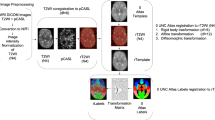Abstract
Globus pallidus involvement is a well-known magnetic resonance (MR) imaging finding of acute kernicterus. However, it is not clear how early the involvement of globus pallidus occurs and whether or not it is seen in every case. Therefore, we aimed to investigate the globus pallidus involvement in 13 neonates with acute kernicterus by MR imaging. Thirteen neonates who were admitted with jaundice, encephalopathy and indirect hyperbilirubinemia (mean, 37.0 mg/dl) were prospectively evaluated with cranial MR imaging. Pathological signal changes were noted concerning the globus pallidus. Eight of the 13 patients demonstrated bilateral, symmetric increased signal intensity in the globus pallidus on T1-weighted MR imaging. These lesions were not apparent on T2-weighted images. Multiple parenchymal punctuate T1 hyperintense lesions were detected in one patient without globus pallidus involvement. This appearance was consistent with hemorrhage. The MR imaging findings of the other four patients showed no evidence of abnormality. The symmetric involvement of globus pallidus seen as hyperintense on T1-weighted MR imaging is a common and characteristic finding of acute kernicterus.


Similar content being viewed by others
References
Barkovich AJ (2000) Pediatric neuroimaging. Lipincott Williams and Wilkins, Philadelphia, pp 209–211
Maisels MJ (1999) Jaundice. In: Avery GB, Fletcher MA, MacDonald MG (eds) Neoanatology. Pathophysiology and management of the newborn. Lippincott Williams and Wilkins, Philadelphia, pp 794–795
Newman TB, Maisels MJ (2002) Magnetic resonance imaging and kernicterus. Pediatrics 109:555
Turkel SB, Miller CA, Guttenberg ME, Moynes DR, Hodgman JE (1982) A clinical pathologic reappraisal of kernicterus. Pediatrics 69:267–272
Kim MH, Yoon JJ, Sher J, Brown AK (1980) Lack of predictive indices in kernicterus: a comparison of clinical and pathologic factors in infant with or without kernicterus. Pediatrics 66:852–858
Johnston MV, Hoon AH Jr (2000) Possible mechanisms in infants for selective basal ganglia damage from asphyxia, kernicterus, or mitochondrial encephalopathies. J Child Neurol 15:588–591
Yilmaz Y, Alper G, Kiliçorlu G, Çelik L, Karadeniz L, Degirmenci-Yilmaz S (2001) MR imaging findings in patients with severe neonatal indirect hyperbilirubinemia. J Child Neurol 16:452–455
Yokochi K (1995) Magnetic resonance imaging in children with kernicterus. Acta Paediatr 84:937–939
Sugama S, Soeda, Eto Y (2001) Magnetic resonance imaging in three children with kernicterus. Pediatr Neurol 25:328–331
Yilmaz Y, Ekinci G (2002) Thalamic involvement in a patient with kernicterus. Eur Radiol 12:1837–1839
Steinborn M, Seelos KC, Heuck A, von Voss H, Reiser M (1999) MR findings in a patient with kernicterus. Eur Radiol 9:1913–1915
Mirowitz SA, Sartor K, Gado M (1990) High-intensity basal ganglia lesions on T1-weighted images in neurofibromatosis. Am J Roentgenol 154:369–373
Mirowitz SA, Westrich TJ, Hirsch JD (1991) Hyperintense basal ganglia on T1-weighted MR images in patients receiving parenteral nutrition. Radiology 181:117–120
Gomori JM, Grossman RI, Shields JA, Augsburger JJ, Joseph PM, DeSimeone D (1986) Choroidal melanomas: correlation of NMR spectroscopy and MR imaging. Radiology 158:443–445
Coskun A, Lequin M, Segal M, Vigneron DB, Ferriero DM, Barkovich AJ (2001) Quantitative analysis of MR images in asphyxiated neonates: correlation with neurodevelopmental outcome. Am J Neuroradiol 22:400–405
Roland EH, Poskitt K, Rodriguez E, Lupton BA, Hill A (1998) Perinatal hypoxic-ischemic thalamic injury: clinical features and neuroimaging. Ann Neurol 44:161–166
Maller AI, Hankins LL, Yeakley JW, Butler IJ (1998) Rolandic type cerebral palsy in children as a pattern of hypoxic-ischemic injury in the full-term neonate. J Child Neurol 13:313–321
Hayashi M, Satoh J, Sakamoto K, Morimatsu Y (1991) Clinical and neuropathological findings in severe athetoid cerebral palsy: a comparative study of globo-Luysian and thalamo-putaminal groups. Brain Dev 13:47–51
Johnson WH, Angara V, Baumal R et al (1967) Erythroblastosis fetalis and hyperbilirubinemia, a five-year follow-up with neurological, psychological, and audiological evaluation. Pediatrics 39:88–92
Penn AA, Enzmann DR, Hahn JS, Stevenson DK (1994) Kernicterus in a full term infant. Pediatrics 93:1003–1006
Martich-Kriss V, Kolias SS, Ball WS (1995) MR findings in kernicterus. Am J Neuroradiol 16:819–821
Harris MC, Bernbaum JC, Polin JR, Zimmerman R, Polin RA (2001) Developmental follow-up of breastfed term and near-term infants with marked hyperbilirubinemia. Pediatrics 107:1075–1080
Govaert P, Lequin M, Swarte R et al (2003) Changes in globus pallidus with (pre)term kernicterus. Pediatrics 112:1256–1263
Author information
Authors and Affiliations
Corresponding author
Rights and permissions
About this article
Cite this article
Coskun, A., Yikilmaz, A., Kumandas, S. et al. Hyperintense globus pallidus on T1-weighted MR imaging in acute kernicterus: is it common or rare?. Eur Radiol 15, 1263–1267 (2005). https://doi.org/10.1007/s00330-004-2502-2
Received:
Revised:
Accepted:
Published:
Issue Date:
DOI: https://doi.org/10.1007/s00330-004-2502-2




